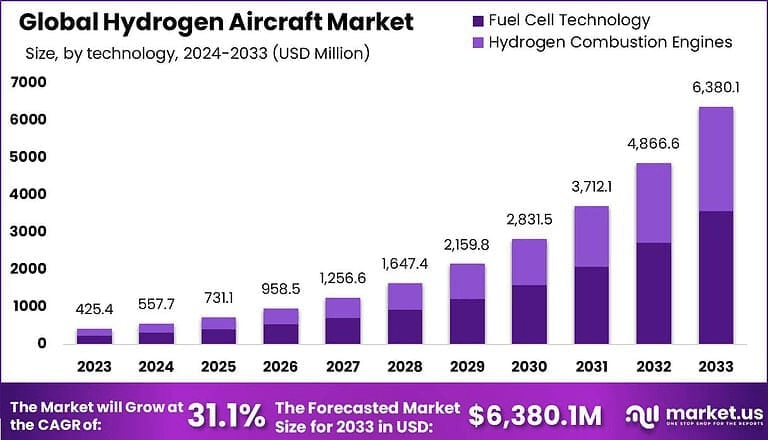Navigating Tariff Challenges: Strategies for the Growing Hydrogen Aircraft Market
Key Ideas
- The global hydrogen aircraft market is poised for significant growth, projected to increase from USD 425.4 million in 2023 to USD 6,380.1 million by 2033 with a strong CAGR of 31.1%.
- Rising tariffs are impacting the market by increasing production costs, disrupting supply chains, and potentially slowing down the adoption of hydrogen aircraft technologies.
- Businesses in the sector need to diversify supply chains, explore local manufacturing options, and invest in cost-effective technologies to navigate tariff challenges and ensure competitiveness.
- North America leads the market with over 40% global share, generating USD 170.2 million in revenue, emphasizing the region's dominance in hydrogen aircraft adoption.
The Global Hydrogen Aircraft Market is witnessing remarkable growth, with projections indicating a substantial increase from USD 425.4 million in 2023 to USD 6,380.1 million by 2033, reflecting a robust CAGR of 31.1%. North America stands out as the dominant region in this market, holding over 40% of the global share in 2023 and generating USD 170.2 million in revenue.
The passenger aircraft segment leads the market, accounting for more than 60.3% of the share, with medium-range aircraft (1,501 to 4,000 nmi) capturing a significant 44% share. Fuel cell technology plays a central role in the market, representing 56% of the share, and the commercial aviation sector shows the largest adoption potential with over 51% market share.
Tariffs are significantly impacting the hydrogen aircraft market by raising the costs of essential components like fuel cells, hydrogen tanks, and aerospace materials. These tariff-induced cost increases directly affect production costs and can hamper the advancement of new hydrogen-powered aircraft technologies. The disruptions in global supply chains caused by tariffs can lead to delays in critical part deliveries, potentially hindering the scalability of hydrogen aviation technologies, particularly in regions heavily reliant on international suppliers.
To counter the challenges posed by rising tariffs, businesses in the hydrogen aircraft market must implement strategies like diversifying supply chains, exploring local manufacturing options, and investing in cost-effective technologies less affected by tariffs. By adopting flexible approaches and focusing on fuel efficiency and operational cost reduction, companies can offset the higher production expenses, ensuring competitiveness in the market.
Despite tariff challenges, analysts project a positive outlook for the hydrogen aircraft market, fueled by the increasing demand for sustainable aviation solutions. The commercial aviation sector's embrace of hydrogen technologies is expected to drive market growth as regulations push for greener aviation alternatives. By navigating tariff hurdles effectively and embracing sustainable practices, businesses can capitalize on the growing opportunities in the hydrogen aircraft sector.
Topics
North America
Aviation Industry
Fuel Cell Technology
Supply Chain
Business Strategies
Market Growth
Regional Analysis
Global Business
Tariff Impact
Latest News
